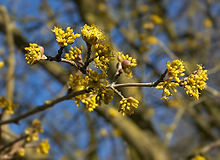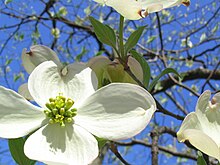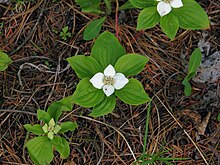Cornus
| Cornus Temporal range:Late Campanian–Holocene,
| |
|---|---|

| |
| Cornus kousavar.chinensis | |
| Scientific classification | |
| Kingdom: | Plantae |
| Clade: | Tracheophytes |
| Clade: | Angiosperms |
| Clade: | Eudicots |
| Clade: | Asterids |
| Order: | Cornales |
| Family: | Cornaceae |
| Genus: | Cornus L. |
| Type species | |
| Cornus mas | |
| Subgenera | |
| |
| Synonyms | |
|
ChamaepericlimenumHill | |







Cornusis agenusof about 30–60species[Note 1]ofwoody plantsin thefamilyCornaceae,commonly known asdogwoodsorcornels,which can generally be distinguished by their blossoms, berries, and distinctive bark.[3]Most aredeciduoustreesorshrubs,but a few species are nearly herbaceousperennialsubshrubs, and some species areevergreen.Several species have small heads of inconspicuous flowers surrounded by aninvolucreof large, typically white petal-likebracts,while others have more open clusters ofpetal-bearing flowers. The various species of dogwood arenativethroughout much oftemperateandborealEurasia and North America, with China, Japan, and the southeastern United States being particularly rich in native species.
Species include the common dogwoodCornus sanguineaof Eurasia, the widely cultivated flowering dogwood(Cornus florida)of eastern North America, the Pacific dogwoodCornus nuttalliiof western North America, the Kousa dogwoodCornus kousaof eastern Asia, and two low-growing boreal species, the Canadian and Eurasian dwarf cornels (or bunchberries),Cornus canadensisandCornus suecicarespectively.
Depending on botanical interpretation, the dogwoods are variously divided into one to ninegeneraorsubgenera;a broadly inclusive genusCornusis accepted here.
Terminology
[edit]Cornusis the Latin word for the cornel tree,Cornus mas. The namecorneldates to the 1550s, via German from Middle Latincornolium,ultimately from the diminutivecornuculum,ofcornum,the Latin word for the cornel cherry.Cornusmeans "horn",[4] presumably applied to the cherry after the example ofκερασός,the Greek word for "cherry", which itself is of pre-Greek origin but reminiscent ofκέρας,the Greek word for "horn".
The name "dog-tree" entered the English vocabulary before 1548, becoming "dogwood" by 1614. Once the name dogwood was affixed to this kind of tree, it soon acquired a secondary name as the hound's tree, while the fruits came to be known as "dogberries" or "houndberries" (the latter a name also for the berries ofblack nightshade,alluding toHecate'shounds).[citation needed]
The name was explained, from as early as the 16th century itself, as derived fromdag"skewer",[5][6]as the wood of the tree was said to have been used to make butcher's skewers. This is uncertain, as the form*dagwoodwas never attested. It is also possible that the tree was named for its berry, calleddogberryfrom at least the 1550s, where the implication could be that the quality of the berry is inferior, as it were "fit for a dog".[7]

An older name of the dogwood in English iswhipple-tree,occurring in a list of trees (aswhipultre) inGeoffrey ChaucerCanterbury Tales.[8] This name is cognate with theMiddle Low Germanwipel-bom"cornel", Dutchwepe, weype"cornel" (thewh-in Chaucer is unetymological, the word would have been Middle Englishwipel). The tree was so named for waving its branches, c.f. Middle Dutchwepelen"totter, waver", Frisianwepeln,Germanwippen.[9]
The namewhippletree,alsowhiffle-tree,now refers to an element of the traction of a horse-drawn cart linking the draw pole of the cart to the harnesses of the horses in file. In this sense it is first recorded in 1733. This mechanism was usually made from oak or ash (and not from dogwood), and it is unlikely that there is a connection to the name forwhipple-treefor Cornus.[10]
Description
[edit]Dogwoods have simple, untoothedleaveswith theveinscurving distinctively as they approach the leaf margins. Most dogwood species have opposite leaves, while a few, such asCornus alternifoliaandC. controversa,have their leaves alternate. Dogwoodflowershave four parts. In many species, the flowers are borne separately in open (but often dense) clusters, while in various other species (such as theflowering dogwood), the flowers themselves are tightly clustered, lacking showypetals,but surrounded by four to six large, typically white petal-likebracts.[citation needed]
Thefruitsof all dogwood species aredrupeswith one or two seeds, often brightly colorful. The drupes of species in the subgenusCornusare edible. Many are without much flavor.Cornus kousaandCornus masare sold commercially as edible fruit trees. The fruits ofCornus kousahave a sweet, tropical pudding like flavor in addition to hard pits. The fruits ofCornus masare both tart and sweet when completely ripe. They have been eaten in Eastern Europe for centuries, both as food and medicine to fight colds and flus. They are very high invitamin C.By contrast, the fruits of species in subgenusSwidaare mildly toxic topeople,though readily eaten bybirds.[citation needed]
Dogwoods are used as food plants by thelarvaeof some species ofbutterflies and moths,including theemperor moth,the engrailed,thesmall angle shades,and the following case-bearers of the genusColeophora:C. ahenella,C. salicivorella(recorded onCornus canadensis),C. albiantennaella,C. cornellaandC. cornivorella,with the latter three all feeding exclusively onCornus.[citation needed]
Uses
[edit]Dogwoods are widely planted horticulturally, and the dense wood of the larger-stemmed species is valued for certain specialized purposes. Cutting boards and fine turnings can be made from this fine grained and beautiful wood. Over 32 different varieties of game birds, including quail, feed on the red seeds.[11]
Horticulture
[edit]Various species ofCornus,particularly theflowering dogwood(Cornus florida),are ubiquitous in Americangardensandlandscaping;horticulturistDonald Wymanstated, "There is a dogwood for almost every part of the U.S. except the hottest and driest areas".[12]In contrast, inNorthwest Europethe lack of sharp winters and hot summers makesCornus floridavery shy of flowering.[13]
OtherCornusspecies arestoloniferousshrubs that grow naturally in wet habitats and along waterways. Several of these are used along highways and in naturalizing landscape plantings, especially those species with bright red or bright yellow stems, particularly conspicuous in winter, such asCornus stolonifera.
The followingcultivars,of mixed or uncertain origin, have gained theRoyal Horticultural Society'sAward of Garden Merit(confirmed 2017):[14]
Fruits
[edit]The speciesCornus masis commonly cultivated in southeastern Europe for its showy, edible berries, that have the color of the carnelian gemstone. Cornelian-cherries have one seed each and are used in syrups and preserves.[19]
Wood
[edit]Dense and fine-grained, dogwood timber has a density of 0.79 and is highly prized for making loom shuttles, tool handles, roller skates and other small items that require a very hard and strong wood.[20]Though it is tough for woodworking, some artisans favor dogwood for small projects such aswalking canes,arrow making,mountain dulcimersand fineinlays.Dogwood wood is an excellent substitute forpersimmonwood in the heads of certaingolf clubs( "woods" ). Dogwood lumber is rare in that it is not readily available with any manufacturer and must be cut down by the person(s) wanting to use it.[citation needed]
Larger items have also been occasionally made of dogwood, such as the screw-in basket-style wine or fruit presses. The first kinds oflaminatedtennis racketswere also made from this wood, cut into thin strips.[citation needed]
Dogwoodtwigswere used by U.S. pioneers to brush their teeth. They would peel off the bark, bite the twig and then scrub their teeth.[21]
Traditional medicine
[edit]The bark ofCornusspecies is rich intanninsand has been used intraditional medicineas a substitute for quinine.[clarification needed][22]During theAmerican Civil War,confederate soldiersmade a tea from the bark to treat pain and fevers, and used dogwood leaves in apoulticeto cover wounds.[23][unreliable source?]
The Japanese cornel,C. officinalis,is used intraditional Chinese medicineasshān zhū yúfor several minor ailments.[24]
Classification
[edit]The following classification recognizes a single, inclusive genusCornus,[25][26]with four subgroups and ten subgenera supported by molecular phylogeny.[27][28][29]Geographical ranges asnative plantsare given below. In addition, cultivated species occasionally persist or spread from plantings beyond their native ranges, but are rarely if ever locallyinvasive.[citation needed]
Blue- or white-fruited dogwoods
[edit]Paniculate or corymbosecymes;bracts minute, nonmodified; fruits globose or subglobose, white, blue, or black:
- SubgenusYinquania.Leaves opposite to subopposite; fall blooming.
- Cornus oblonga.East Asia from Pakistan through the Himalayas and China.[30]
- Cornus peruviana.Costa Rica and Venezuela to Bolivia.[31][32]
- SubgenusKraniopsis.Leaves opposite; summer blooming.
- Cornus alba[Note 2](Siberian dogwood).Siberiaand northern China.
- Cornus amomum[Note 3](silky dogwood). EasternU.S.east of the Great Plains except for theDeep South.
- Cornus asperifolia(toughleaf dogwood). Southeastern U.S.
- Cornus austrosinensis(South China dogwood). East Asia.
- Cornus bretschneideri(Bretschneider's dogwood). Northern China.
- Cornus coreana(Korean dogwood). Northeast Asia.
- Cornus drummondii(roughleaf dogwood). U.S. between theAppalachiaand theGreat Plains,and southernOntario,Canada.
- Cornus excelsa.Mexico to Honduras.
- Cornus foemina(stiff dogwood) Southeastern and southern United States.
- Cornus glabrata(brown dogwood or smooth dogwood). WesternNorth America.
- Cornus hemsleyi(Hemsley's dogwood). Southwest China.
- Cornus koehneana(Koehne's dogwood). Southwest China.
- Cornus macrophylla(large-leafed dogwood;Chinese:棶 mộc;pinyin:láimù). East Asia.
- Cornus obliqua[Note 4](pale dogwood). Northeastern and central U.S., and southeastern Canada.
- Cornus paucinervis.China.
- Cornus racemosa(northern swamp dogwood or gray dogwood). Northeastern and central U.S., and extreme southeastern Canada.
- Cornus rugosa(round-leaf dogwood). Northeastern and north-central U.S., and southeastern Canada.
- Cornus sanguinea(common dogwood). Europe.
- Cornus sericea[Note 5](red osier dogwood). Northern and western North America, exceptArcticregions.
- Cornus walteri(Walter's dogwood). Central China.
- Cornus wilsoniana(ghost dogwood). China.
- Cornus × arnoldiana(Hybrid:C. obliqua×C. racemosa). Eastern North America.
- SubgenusMesomora.Leaves alternate; summer blooming.
- Cornus alternifolia(pagoda dogwood or alternate-leaf dogwood). Eastern U.S. and southeastern Canada.
- Cornus controversa(table dogwood). East Asia.
Cornelian cherries
[edit]Umbellate cymes; bracts modified, non-petaloid; fruits oblong, red; stone walls filled with cavities:
- SubgenusAfrocrania.Dioecious, bracts 4.
- Cornus volkensii.Afromontaneeastern Africa.
- SubgenusCornus.Plants hermaphroditic, bracts 4 or 6
- Cornus eydeana.Yunnan in China
- Cornus mas(European cornel or Cornelian-cherry).Mediterranean.
- Cornus officinalis(Japanese cornel). China,Japan,Korea.
- †Cornus piggae(Late Paleocene,North Dakota)[33]
- Cornus sessilis(blackfruit cornel).California.
- SubgenusSinocornus.Plants hermaphroditic, bracts 4 or 6
- Cornus chinensis(Chinese cornel).China.
Big-bracted dogwoods
[edit]Capitular cymes:
- SubgenusDiscocrania.Bracts 4, modified, non-petaloid; fruits oblong, red.
- Cornus disciflora.Mexico and Central America
- SubgenusCynoxylon.Bracts 4 or 6, large and petaloid, fruits oblong, red.
- Cornus florida(flowering dogwood). U.S. east of the Great Plains, north to southern Ontario.
- Cornus nuttallii(Pacific dogwood). Western North America, fromBritish ColumbiatoCalifornia.
- SubgenusSyncarpea.Bracts 4, large and petaloid, fruits red, fused into a compound multi-stoned berry.
- Cornus capitata(Himalayan flowering dogwood).Himalaya.
- Cornus hongkongensis(Hong Kong dogwood). Southern China,Laos,Vietnam.
- Cornus kousa(Kousa dogwood). Japan and (as subsp.chinensis) central and northern China.
- Cornus multinervosa.Yunnan and Sichuan provinces of China
Dwarf dogwoods
[edit]Minute corymbose cymes; bracts 4, petaloid; fruit globose, red; rhizomatous herb:
- SubgenusArctocrania.
- Cornus canadensis(Canadian dwarf cornel or bunchberry) Northern North America, southward in theAppalachianandRockyMountains.
- Cornus suecica(Eurasian dwarf cornel or bunchberry). Northern Eurasia, locally in extreme northeast and northwest North America.
- Cornus × unalaschkensis(Hybrid:C. canadensis×C. suecica).Aleutian Islands(Alaska),Greenland,andLabradorandNewfoundlandin Canada.
Incertae sedis(unplaced)
[edit]- †Cornus clarnensis(MiddleEocene,Central Oregon)[34]
Horticultural hybrids
[edit]Cornus×rutgersensis(Hybrid:C. florida×C. kousa). Horticulturally developed.[35]
Cultural references
[edit]Theinflorescenceof thePacific dogwood(Cornus nuttallii)is the official flower of the province ofBritish Columbia.Theflowering dogwood(Cornus florida) and itsinflorescenceare the state tree and the state flower respectively for the U.S. Commonwealth ofVirginia.It is also the state tree ofMissouriand the state flower ofNorth Carolina,[36]and the state memorial tree ofNew Jersey.[37]The term "dogwood winter", incolloquialuse in the American Southeast, especially Appalachia,[38]is sometimes used to describe acold snapin spring, presumably because farmers believed it was not safe to plant their crops until after the dogwoods blossomed.[39]
Anne Morrow Lindberghgives a vivid description of the dogwood tree in her poem "Dogwood".[40]
Notes
[edit]- ^58 species according to Xianget al.(2006)[2]
- ^Cornus sericea,treated separately here, is sometimes included in a more broadly taken concept ofCornus alba,which in that sense is also native in North America.
- ^Cornus obliqua,here recognized separately, has been included in a broader concept ofC. amomumby some botanists. Canadian reports forC. amomumare apparently all based on plants here classified asC. obliqua.
- ^Cornus obliquais sometimes included in a more broadly taken concept ofC. amomum,also in the eastern U.S.
- ^Cornus sericea(includingC. stolonifera) is sometimes itself included in a more broadly taken concept of the otherwise EurasianCornus alba.
References
[edit]- ^Atkinson, Brian A.; Stockey, Ruth A.; Rothwell, Gar W. (2016)."Cretaceous origin of dogwoods: an anatomically preservedCornus(Cornaceae) fruit from the Campanian of Vancouver Island ".PeerJ.4:e2808.doi:10.7717/peerj.2808.PMC5180587.PMID28028474.
- ^Qiu-Yun (Jenny) Xiang; David T. Thomas; Wenheng Zhang; Steven R. Manchester & Zack Murrell (2006). "Species level phylogeny of the genusCornus(Cornaceae) based on molecular and morphological evidence – implications for taxonomy and Tertiary intercontinental migration ".Taxon.55(1): 9–30.doi:10.2307/25065525.JSTOR25065525.
- ^"Notable Characteristics of Dogwood Trees".answers. Archived fromthe originalon August 26, 2014.RetrievedAugust 24,2014.
- ^Gledhill, David (2008). "The Names of Plants". Cambridge University Press.ISBN9780521866453(hardback),ISBN9780521685535(paperback). pp 121
- ^Vedel, H., & Lange, J. (1960).Trees and Bushes in Wood and Hedgerow.Metheun & Co. Ltd., London.
- ^Fernald, Merritt Lyndon (1950).Gray's Manual of Botany(8th ed.). New York: American Book Company.
- ^"the first element sometimes said to have been perhaps dag — compare dagger and dag (v.)" to pierce or stab "(1630s, perhaps 15c.). The trees have hard, white wood that was said to have been used in making butchers' skewers; another name for it was skewer-wood. This explanation is as old as the word itself in English, but the form *dagwood is not attested. Another guess is that the tree was given the name in reference to its fruit, which was called dogberry from 1550s, and dog (n.) had implications of" cheap, inferior "(i.e." fit for a dog ")." "dogwood".Online Etymology Dictionary.Douglas Harper.
- ^ook, firre, birch, asp, alder, holm, popler / wilow, elm, plane, ash, box, chasteyn, lind, laurer / mapul, thorn, beech, hasel, ew, whipultre"The Knight's Tale",verse 2065
- ^Walter William Skeat,A Student's Pastime: Being a Select Series of Articles Reprinted from "Notes and Queries",Clarendon Press, 1896,p. 252.
- ^William Shepard Walsh et al. (eds.),American Notes and Queriesvol. 5 (1890) p. 118
- ^"Wildlife Dogwood Trees".Prepper Gardens. Archived fromthe originalon 2013-11-16.RetrievedJanuary 8,2013.
- ^Wyman's Garden Encyclopedia,s.v."Cornus"
- ^Alice M. Coats,Garden Shrubs and their Histories(1964) 1992,s.v."Cornus".
- ^"AGM Plants - Ornamental"(PDF).Royal Horticultural Society. July 2017. p. 16.Retrieved24 January2018.
- ^"RHS Plantfinder -Cornus'Eddie's White Wonder'".Retrieved2 February2018.
- ^"RHS Plantfinder -Cornus'Norman Hadden'".Retrieved2 February2018.
- ^"RHS Plantfinder -Cornus'Ormonde'".Retrieved2 February2018.
- ^"RHS Plantfinder -Cornus'Porlock'".Retrieved2 February2018.
- ^"Cornus mas - Plant Finder".missouribotanicalgarden.org.
- ^"Dogwood." McGraw-Hill Concise Encyclopedia of Science and Technology. New York: McGraw-Hill, 2006. Credo Reference. Web. 17 September 2012.
- ^Gunn, John C. (1835).Gunn's Domestic Medicine(4th ed.). John M. Gallagher, printer. p.523.
- ^"Dogwood or cornel." The Columbia Encyclopedia. New York: Columbia University Press, 2008. Credo Reference. Web. 17 September 2012.
- ^"Medicinal Dogwood Trees".Prepper Gardens. Archived fromthe originalon 2013-11-16.RetrievedJanuary 8,2013.
- ^Schafer, Peg (2011).The Chinese Medicinal Herb Farm: A Cultivator's Guide to Small-scale Organic Herb Production.Chelsea Green Publishing. pp. 312 (page 150).ISBN9781603583305.
- ^Richard H. Eyde (1987). "The case for keepingCornusin the broad Linnaean sense ".Systematic Botany.12(4): 505–518.doi:10.2307/2418886.JSTOR2418886.
- ^Richard H. Eyde (1988). "ComprehendingCornus:puzzles and progress in the systematics of the dogwoods ".Botanical Review.54(3): 233–351.Bibcode:1988BotRv..54..233E.doi:10.1007/bf02868985.JSTOR4354115.S2CID12507834.
- ^Fan, Chuanzhu; Xiang, Qiu-Yun (2001)."Phylogenetic relationships withinCornus(Cornaceae) based on 26S rDNA sequences ".American Journal of Botany.88(6): 1131–1138.doi:10.2307/2657096.JSTOR2657096.PMID11410478.
- ^Zhiang, Qiu-Yun; Thomas, David T.; Zhang, Wenheng; Manchester, Steven R.; Murrell, Zack (2006)."Species level phylogeny of the genus Cornus (Cornaceae) based on molecular and morphological evidence—implications for taxonomy and Tertiary intercontinental migration".Taxon.55(1).Retrieved29 January2016.
- ^Nowicki, Marcin; Boggess, Sarah L.; Saxton, Arnold M.; Hadziabdic, Denita; Xiang, Qiu-Yun Jenny; Molnar, Thomas; Huff, Matthew L.; Staton, Margaret E.; Zhao, Yichen (2018-10-23). Heinze, Berthold (ed.)."Haplotyping of Cornus florida and C. kousa chloroplasts: Insights into species-level differences and patterns of plastic DNA variation in cultivars".PLOS ONE.13(10): e0205407.Bibcode:2018PLoSO..1305407N.doi:10.1371/journal.pone.0205407.ISSN1932-6203.PMC6198962.PMID30352068.
- ^"Cornus oblonga - Wall".Plants For A Future.RetrievedFebruary 9,2022.
- ^"Tropicos | Name - Cornus peruviana J.F. Macbr".tropicos.org.Retrieved2016-01-29.
- ^Macbride, J.F. (1959). "Cornaceae".Flora of Peru.Vol. 13 pt.5 no.1. Field Museum. pp. 44–45.
- ^Manchester, S.R.; Xiang, X-P.; Xiang, Q-Y (2010)."Fruits of Cornelian Cherries (Cornaceae:CornusSubg.Cornus) in the Paleocene and Eocene of the Northern Hemisphere "(PDF).International Journal of Plant Sciences.171(8): 882–891.doi:10.1086/655771.S2CID83524109.[permanent dead link]
- ^Manchester, S.R. (1994). "Fruits and Seeds of the Middle Eocene Nut Beds Flora, Clarno Formation, Oregon".Palaeontographica Americana.58:30–31.
- ^"Cornus florida×Cornus kousa".Landscape Plants: Images, identification, and information.Oregon State University.Retrieved20 May2011.
- ^"Find Official State Flower for USA | Teleflora".teleflora.
- ^"List of State Trees | State Symbols USA".statesymbolsusa.org.23 April 2014.
- ^Jenkins, Mary Tom (2021-03-31)."The Six Little Winters of Tennessee".Visit Cleveland TN.Retrieved2023-12-28.
- ^"What is Dogwood Winter? | Farmers' Almanac".Archived fromthe originalon 2011-05-03.Retrieved2011-05-20.
- ^Morrow, Anne (1956).Dogwood.New York: Pantheon Books. pp. 38–39.
External links
[edit]- Dogwood history and usesArchived2016-03-03 at theWayback Machine
- Cornusin Flora of China
